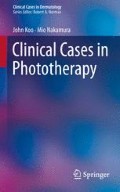Abstract
Rarely, there are patients who are unable to tolerate NB-UVB due to skin irritation. Such patients are often able to tolerate BB-UVB. Although some studies point that NB-UVB may be more effective than BB-UVB, when a patient cannot tolerate NB-UVB, BB-UVB is a good alternative treatment option. Likewise, patients who cannot tolerate BB-UVB may be able to tolerate NB-UVB.
Keywords
These keywords were added by machine and not by the authors. This process is experimental and the keywords may be updated as the learning algorithm improves.
Case
A 51-year-old male with generalized psoriasis starts NB-UVB phototherapy. NB-UVB dosimetry is initiated per protocol. However, within 1–2 weeks of starting, the patient complains that his skin feels quite irritated following each treatment. Initially, he was thought to have “initiation burn” (see Chap. 7) and lower dosimetry with careful titration was attempted. However, despite the most careful dosimetry modulation, the patient still complained of irritation after each NB-UVB exposure. He denies past medical history of photosensitizing diseases such as systemic lupus erythematosus. You examine the skin to find only lesions consistent with partially-treated psoriasis and no additional primary skin findings to explain the patient’s skin irritation.
Discussion
NB-UVB phototherapy, which emits wavelengths of light between 308 and 313 nm, was purposely designed to optimize the treatment of psoriasis after early studies showed that psoriasis responds better to wavelengths of light closer to 310 nm [1]. However, rarely, there are patients with psoriasis who cannot tolerate NB-UVB due to the skin becoming irritated from the light [2, 3]. The exact cause of this is unclear.
Although some studies point that NB-UVB may be more effective than BB-UVB [4], when a patient cannot tolerate NB-UVB, BB-UVB is a good alternative treatment option [5]. PUVA phototherapy may also be tolerated as the therapeutic light spectrum of PUVA is completely different from that of UVB. If neither BB-UVB nor PUVA are available, heliotherapy utilizing natural sunlight may be an effective and safe therapeutic option provided that it is done in the correct manner (see Chap. 10).
Similarly, there are patients who cannot tolerate BB-UVB but can tolerate NB-UVB. BB-UVB is more commonly used for patients with atopic dermatitis, prurigo nodularis, and chronic pruritus, as it appears to have less irritating effects compared to NB-UVB and is better tolerated [5]; however, this, of course, can vary depending on the individual. Therefore, at the UCSF Phototherapy Unit, there are psoriasis patients who might be categorized as NB-UVB intolerant who are doing very well with BB-UVB. On the other hand, there are patients with atopic dermatitis, other eczema, and chronic pruritus who are intolerant of BB-UVB but do much better with NB-UVB. This is another reiteration of the importance of individualizing treatments to each patient when practicing phototherapy.
References
Huynh M, Debbaneh MG, Levin EC, Koo JYM. The art and practice of phototherapy and laser. In: Koo JYM, Levin EC, Leon A, Wu JJ, Gottlieb AB, editors. Moderate to severe psoriasis. Baton Rouge: CRC Press; 2014. p. 67–97.
Ros AM, Eklund G. Photosensitive psoriasis. An epidemiologic study. J Am Acad Dermatol. 1987;17(5 Pt 1):752–8.
Ros AM. Photosensitive psoriasis. Semin Dermatol. 1992;11(4):267–8.
Lapolla W, Yentzer BA, Bagel J, Halvorson CR, Feldman SR. A review of phototherapy protocols for psoriasis treatment. J Am Acad Dermatol. 2011;64(5):936–49.
Pugashetti R, Lim HW, Koo J. Broadband UVB revisited: is the narrowband UVB fad limiting our therapeutic options? J Dermatolog Treat. 2010;21(6):326–30.
Author information
Authors and Affiliations
Rights and permissions
Copyright information
© 2017 Springer International Publishing AG
About this chapter
Cite this chapter
Koo, J., Nakamura, M. (2017). When Patients Cannot Tolerate Narrowband-UVB. In: Clinical Cases in Phototherapy. Clinical Cases in Dermatology. Springer, Cham. https://doi.org/10.1007/978-3-319-51599-1_9
Download citation
DOI: https://doi.org/10.1007/978-3-319-51599-1_9
Published:
Publisher Name: Springer, Cham
Print ISBN: 978-3-319-51598-4
Online ISBN: 978-3-319-51599-1
eBook Packages: MedicineMedicine (R0)

